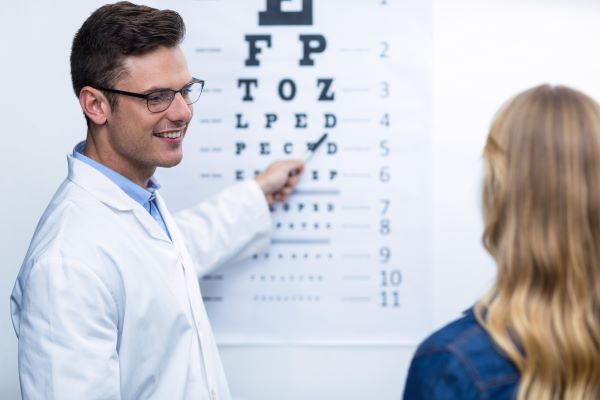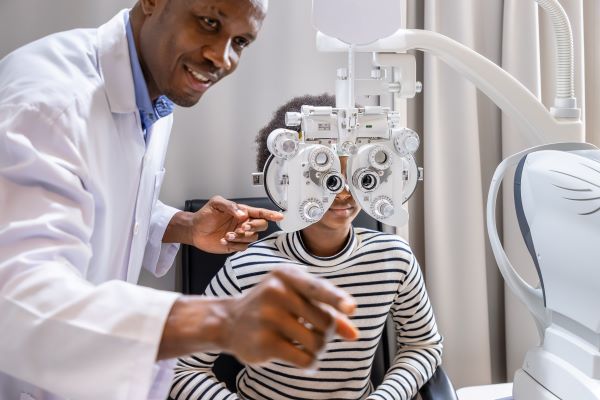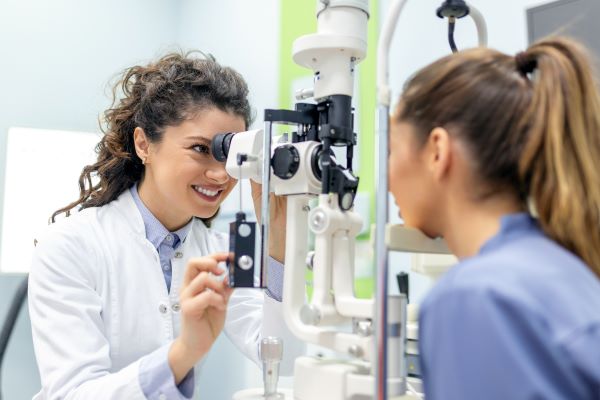If you have an interest in eye care and want to work in a role where you would provide primary care and treatment directly to patients in a clinical setting, you may make an excellent optometrist. This career requires a doctoral-level education with an extensive clinical training component, but the difference you can make in performing vision screening and vision therapy can literally help patients see the world around them more clearly.

What Is an Optometrist?
An optometrist is a health care practitioner who specializes in the practice of optometry, the field which focuses on the comprehensive examination and primary care and treatment of the eyes and related structures. Optometrists, as doctors of optometry are called, have an advanced, specialized education that qualifies them to perform routine vision screenings and prescribe glasses and contact lenses to correct vision problems like nearsightedness or farsightedness.
Do Optometrists Diagnose and Treat Eye Diseases?
Performing an eye exam, prescribing eyeglasses and contact lenses and administering vision therapy are the most common responsibilities you take on when you become an optometrist. Prospective optometry students often wonder whether this primary eye care provider has a role in treating other conditions, as well.
A licensed optometrist, particularly one with additional specialty training beyond the regular optometry school curriculum, may identify common eye problems such as glaucoma and macular degeneration, cataracts and other conditions. Undergoing comprehensive eye examinations is important not only for the health of your eyes, but for your entire body. An eye exam can provide a glimpse into health issues ranging from high blood pressure, diabetes and brain tumors, which can also affect your vision.
As they practice optometry, an optometrist may provide vision therapy such as low-vision rehabilitation. Some optometrists are authorized to perform minor eye-related surgical procedures – and provide the required preoperative and postoperative care – and prescribe medications.
RELATED: Top 20 In-Demand Healthcare Careers
The Difference Between Optometrists and Ophthalmologists
There’s a lot of overlap between optometrists, primary eye care providers, and ophthalmologists, medical doctors who specialize in eye disease and treatment.
An ophthalmologist may perform some of the same vision care services as an optometrist, including routine vision tests and prescribing glasses and contact lenses for myopia control. However, an optometrist focuses more on routine vision checks and the treatment of common eye problems, while an ophthalmologist is licensed to offer a broader range of medical treatment services for eyes and vision problems.
Optometry differs from ophthalmology primarily in that ophthalmology is a medical specialty that is performed by medical doctors and – like other areas of medical practice – that emphasizes disease, dysfunction and treatment. An optometrist goes to optometry school, while an ophthalmologist goes to medical school and completes at least three years of residency training after finishing their Doctor of Medicine (MD) or Doctor of Osteopathic Medicine (DO) degree.
RELATED: How Long Does It Take to Become a Doctor?
As medical doctors, ophthalmologists are the eye care professionals that patients would see for treatment of more severe, advanced or uncommon eye and vision problems compared to the early-stage and common eye diseases that optometrists treat, according to U.S. News & World Report. While optometrists may perform minor surgical procedures such as correcting ocular abnormalities, ophthalmologists are the health care providers who perform more extensive eye surgeries.
RELATED: What Degree Do I Need to Be an Audiologist?
What Are Optometry Degrees?
The only path toward becoming an optometrist is going to school to earn an optometry degree. Optometry degrees are advanced degrees awarded by a graduate-level college of optometry. The Doctor of Optometry (O.D.) degree is the type of degree awarded by college of optometry doctoral degree programs.
As the title of the degree shows, an optometry degree is a doctoral-level degree. The high-level coursework required to earn your degree in optometry builds upon a strong foundation of undergraduate studies in areas like biology and physical sciences.
How Long Is Optometry School?
Optometry school lasts for four years beyond the student’s undergraduate coursework. In other words, it will take most aspiring optometrists at least eight years of study after finishing high school to prepare for becoming an optometrist. Students who apply to optometry school early – before they finish their bachelor’s degree requirements – may be able to complete their schooling in a total of seven years.
During their four years of optometry school, students learn the basic science concepts needed to practice optometry and the diseases and treatments that are within the scope of an optometrist’s work, as well as gaining extensive clinical optometry experience.
Optometrists may choose to spend an additional year completing residency training in an area of clinical specialty, but residency training isn’t required if optometrists don’t want to specialize. During this optional one-year training, optometrists may gain advanced clinical skills and knowledge in areas such as ocular disease, low vision rehabilitation, family practice, pediatric optometry or geriatric optometry, according to the United States Bureau of Labor Statistics (BLS).

Optometry School Curriculum
When you’re pursuing a Doctor of Optometry degree, it’s important to choose an accredited optometry school. Otherwise, you will have a difficult time obtaining the license you need to practice optometry.
Optometry schools in the United States are accredited by the Accreditation Council on Optometric Education (ACOE) of the American Optometric Association. The ACOE currently recognizes 23 accredited optometry school programs in the U.S. and two programs in Canada.
Doctor of Optometry degree programs usually begin with coursework in basic sciences that pertain to optometry practice and then progress to clinical training experiences. The human eye and visual systems are complex, as are the diseases and abnormalities that affect them, so the optometry school curriculum is a lot to cover in just four years.
For example, at the University of California—Berkeley, first-year optometry students take lecture and laboratory courses in the following:
- The clinical examination of the visual system
- Human anatomy and physiology of the eye and visual system
- Neuroanatomy and neurophysiology of the eye
- Oculomotor functions and neurology
- The optical system
- Geometrical optics
- The Optics of ophthalmic lenses
- Visual perception and sensitivity
- Binocular vision and space perception
Most optometry schools, like the Chicago College of Optometry at Midwestern University, begin introducing students to topics like the visual consequences of disease by the end of their second year of study and the diagnosis and treatment of ocular disease by the end of their third year. Clinical optometry training often becomes the focus of the program midway through the third year of study. In their fourth year – and final year – of school, students learn primarily through clinical experience, developing the skills for practical patient care.

Getting Into Optometry Schools
If you want to become an optometrist, you’re going to need to start preparing for the career early. Taking courses that align with optometry program prerequisites and help students prepare for the required standardized testing should be an aspiring optometrist’s top priority as an undergraduate.
Meeting Optometry School Prerequisites
To succeed in the rigorous coursework required in optometry school, students must have completed undergraduate studies in a variety of subject areas. Without at least some background in these areas, students won’t have the foundation they need to dig into higher-level studies in these disciplines. Courses that students are required to have completed before starting a degree program are known as prerequisites.
The specific prerequisites students must meet may vary across different optometry schools, but most optometry schools will include in this list considerable studies in the sciences. At the State University of New York (SUNY) College of Optometry, for example, required courses include laboratory courses in general biology, general physics, general chemistry and organic chemistry, as well as classes in calculus, statistics, psychology, social science and English composition. The optometry school also recommends that prospective students take courses in microbiology and biochemistry specifically.
Earning a Competitive Score on the Optometry Admission Test
Prospective students of optometry programs have to take the Optometry Admission Test (OAT) before they can apply to optometry school. The OAT consists of four tests, all of which are administered via computer:
- The Survey of Natural Sciences test measures performance on questions concerning biology, general chemistry and organic chemistry.
- The Reading Comprehension test assesses students’ ability to analyze and understand basic scientific information by asking them to read and answer questions based on passages that cover scientific topics.
- The Physics test evaluates prospective students’ knowledge of statics, dynamics, thermodynamics, energy, motion and momentum, waves, circuits, optics and other aspects of physical sciences.
- The Quantitative Reasoning test appraises test-takers’ knowledge of algebra, probability and statistics, data analysis and quantitative comparison through mathematical problems and a word problem.
Scores on the OAT range from 200 to 400. A score of 300 is generally considered to be average, and the average score of students accepted into optometry school is generally between 320 and 330. Individual schools may publish their own average OAT score information based on the students that apply to the school or that are accepted into the program. For example, the average OAT score reported for the Class of 2025 at New England College of Optometry was 327.
Compiling Your Application Package
Submitting OAT scores and proof that you have completed the necessary prerequisites are part of the admissions process, but a student may also be required to submit a variety of other materials for consideration. In their complete application package, future optometrists may need to submit a personal statement that discusses why they would be a good candidate for admission and how they intend to use their optometrist education.
Many schools require applicants to submit letters of recommendation, often from former professors who can speak to the candidate’s dedication and performance as a student. Letters from current or former employers who can attest to your work ethic or from a practicing optometrist whom you shadowed and observed may also add value to your application.
Another factor that affects your ability to get into optometry school is the grades you earned as an undergraduate student. Your transcript doesn’t only show which classes you completed and which degree you earned but also how well you performed in your courses. Optometry school admissions are competitive, and a student with stellar grades has a greater likelihood of being accepted than a student who achieved only average grades throughout their studies.
Fast-Tracking Your Career With a Bachelor’s Degree in Vision Science
The fastest way to become an optometrist is to apply for optometry school early. Instead of finishing your four-year degree and then starting your optometry program, students can apply to optometry school as early as their second year of undergraduate degree coursework. Early admission to an optometry program that awards a Bachelor of Science in Vision Science degree allows students to start their optometry and vision science courses as soon as their senior year (which doubles as their first year of optometry school).
The Bachelor’s Degree Options for Optometry School
You can’t start working toward your Doctor of Optometry until you have earned your bachelor’s degree or at least completed three years of an undergraduate degree. Whether you plan on following the traditional route into the profession or you want to fast-track your training, you need to pick an undergraduate major.
There is no specific major required for aspiring optometrists, as long as you complete the required prerequisites for your program. Most students pursuing a career in eye care will major in a science- or health-related discipline, although doing so is not required.
Some schools, like the Rosenberg School of Optometry at the University of the Incarnate Word, offer a four-year pre-optometry bachelor’s degree program that includes optometry courses like visual optics, applied vision science, ophthalmic lenses and optical design, visual pharmacological sciences and neuroscience of the visual system. General science disciplines are more common majors for aspiring optometrists.
Biology
Majoring in biology, the scientific study of life and living things, is a good option for optometrists and other health care practitioners. Biology majors take courses such as general biology, cell biology, molecular biology, genetics and physiology.
Chemistry
Students of chemistry take a variety of courses that pertain to the study of the properties of matter and how they react to physical forces and other substances, including general chemistry, organic and inorganic chemistry, physical chemistry and analytical chemistry.
Physics
Physics, the branch of science concerned with matter and its motion and behavior throughout space and time, is one of the content areas on which aspiring optometrists are tested in the OAT. A physics major will take courses in waves, vibrations, optics, electricity, magnetism, mechanics and thermodynamics.
Health Sciences
If you want to prepare for clinical training and the challenges of caring for patients, any sort of health sciences major can be beneficial. Health sciences programs typically include basic science coursework in biology, chemistry and physics as well as courses specific to health science, including epidemiology, healthcare management, laws and ethics in healthcare and healthcare systems.

Getting Licensed as an Optometrist
Before graduates from an optometry school can become practicing optometrists, they need to undergo a licensing process. In most states, the most important requirements for becoming a licensed optometrist are earning a degree from an accredited program and passing the National Board of Examiners in Optometry examination.
Optometrist Licensing Exam Pass Rates
As of 2021, the national average ultimate pass rate among students at all optometry schools was 92.46%, according to the Association of Schools and Colleges of Optometry (ASCO). Most optometry schools reported pass rates in the mid-80% to high-90% range. Some individual schools of optometry report significantly higher pass rates n the national licensing exam than others.
The Southern College of Optometry reported the highest pass rate for the 2020 through 2021 year, with an impressive 99.24% of its graduates passing the licensing exam. Other schools with the highest pass rates include Chicago College of Optometry at Midwestern University and the University of Alabama at Birmingham, both with a pass rate of 97.78%, and Ferris State University, with a pass rate of 97.22%. Other optometry schools’ pass rates were slightly below the national average.
Six schools reported pass rates in the 80%-range for this exam period:
- 89.39% for New England College of Optometry
- 86.36% for Northeastern State University Oklahoma College of Optometry
- 85.71% for Inter American University of Puerto Rico School of Optometry
- 85.37% for Salus University
- 85.14% for Western University of Health Sciences
- 81.48% for the University of Pikeville
Only one school reported an exam pass rate for this period below 80%: Massachusetts College of Pharmacy and Health Sciences (MCPHS) University, with a pass rate of 75.00%.
Once you pass the National Board of Examiners in Optometry exam, you must complete continuing education courses as required by your state to maintain your license in good standing.
Additional Resources
What Is the Benefit of an MSN Degree Vs a BSN Degree?
What Is the Benefit of a Biomedical Engineering Degree Vs a Medical Degree?
Top 10 Highest Paying Medical Specialties
Top 20 In-Demand Healthcare Careers

